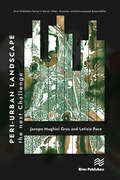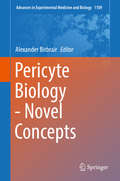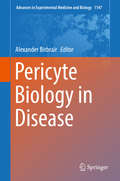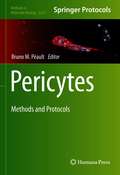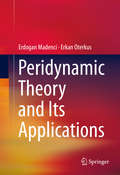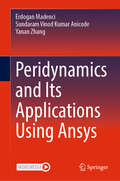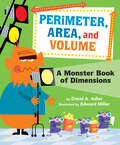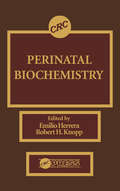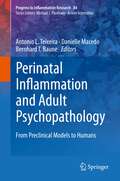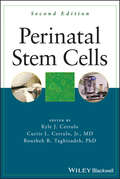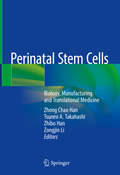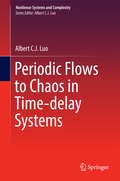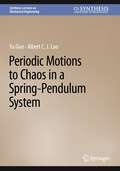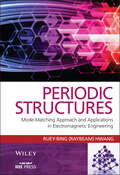- Table View
- List View
Performing Farmscapes (Performing Landscapes)
by Susan C. HaedickeThis book argues that the performance-based work in the featured case studies contributes to the construction of food democracy where the public takes back decision-making in shaping the food system. It explores how contemporary artists translate scientific research about local and global agricultural issues into life stories that inform and engage their audiences and, in so doing, transform passive food consumers into proactive food citizens. The pairing of performing and farmscapes (complex webs of farmlands and storylines) enables artists to use embodied practices to encourage audiences to imagine a just and sustainable agri-food system and to collaborate on making it a reality. The book arranges the case studies on a trajectory that moves from projects that foreground knowledge acquisition to ones that emphasize social engagement by creating conversations and coalitions between farming and nonfarming communities to a final one that pairs protest art and political activism to achieve legally-binding changes in the agricultural landscape.
Performing Feeling in Cultures of Memory
by Bryoni TrezisePerforming Feeling in Cultures of Memory brings memory studies into conversation with a focus on feelings as cultural actors. It charts a series of memory sites that range from canonical museums and memorials, to practices enabled by the virtual terrain of Second Life, popular 'trauma TV' programs and radical theatre practice.
Performing Homescapes (Performing Landscapes)
by Sally Mackey Adelina OngPart of the Performing Landscapes series, Performing Homescapes is an edited collection comprising a contemporary exploration of performing many iterations of landscapes of homes. Authors were invited to respond to a detailed brief with home to be deliberately reconsidered as homescape, represented by landscapes, sites and practices often outside, and occasionally including a conventional home-as-house and intimate dwelling. We wanted a diverse range of geographical sites to be represented and a global offer, encompassing a pluriverse of homescapes. Voices, practices, and epistemologies from the Global South and global majority were important to us, including Indigenous ways of knowing and practicing. This curated collection offers an expanded understanding of the performance of home/scapes as a new intervention into the fields of performance and home scholarship. Performing Homescapes moves beyond spatial meditations within rooms of a house to offer an original critical engagement with the social, political, ecological and cultural landscapes that shape and sustain affects related to the notion of home, unhomeliness and, even, solastalgia. While the impact of the social, political and cultural landscapes on relationships with - and within - the house are implied in most academic literature on forms of performing home, it is foregrounded in the chapters of this edited collection. In addition, certain chapters attend to the more-than-human, human relationships with the Earth as homescape and the co-creation of homescapes within and beyond dwellings.
Performing the Nonhuman: Towards a Theatre of Transformation (ISSN)
by Conrad AlexandrowiczThis book radically reimagines theatre/performance pedagogy and dramaturgy in response to the accelerating climate crisis.This text is founded upon the principle that the theatre is the most anthropocentric of all the arts: the means of its representation, the human figure, is identical with its conventional object, the human narrative, broadly considered. In order to respond ethically to the climate crisis, it must expand its range to include performing as/in response to the nonhuman. Conrad Alexandrowicz concisely explores theoretical approaches to the other‑than‑human, found in the work of, among others, Jane Bennett, Timothy Morton, Rosi Braidotti, and Cary Wolfe. The implications of this move are far‑reaching and commence with displacing realism from its traditional position of dominance. The practices of 20th century physical theatre visionaries such as Tadeusz Kantor, Jacques Lecoq, and Jerzy Grotowski are revisited and reconsidered for their applicability to forms of theatre that might serve the needs of establishing storytelling deriving from nonhuman phenomena. This logically leads to the matter of responding appropriately to Indigenous ways of knowing and being. The work finds guidance in Indigenous, pre‑scientific ways of knowing and being, such as those articulated by Robin Wall Kimmerer (Braiding Sweetgrass, 2013). In contemplating our kinship with vegetative life, the work finds inspiration in the latest research into the ways tree communities communicate, collaborate, and share resources, including the work of Suzanne Simard (Finding the Mother Tree, 2021). It next imagines transformations in how theatre is situated, delivered, and received and considers the ways in which the performer/spectator binary may have to be reconfigured, with particular reference to Grotowski’s experiments in participatory theatre. It poses an even more provocative question: is such theorized performance work pointing in the direction of some re‑imagined version of ritual and ceremony that may find antecedents in pre‑Christian European belief and practice? Finally, it locates such eco‑theatre in the realm of healing: climate anxiety, depression, and grief on the part of instructors, students, and artists will require us to consider and activate the healing power of the art form; perhaps, the core purpose of all the arts will shift to support the need to generate solace in times of fear, anger, and uncertainty.This book is intended for instructors, both scholars and performance pedagogues, in theatre and performance studies, as well as graduate and undergraduate students in these areas.
Perfusion Cell Culture Processes for Biopharmaceuticals: Process Development, Design, and Scale-up (Cambridge Series in Chemical Engineering)
by Massimo Morbidelli Moritz Wolf Jean-Marc BielserMaster the design and operation of perfusion cell cultures with this authoritative reference. Discover the current state-of-the-art in the design and operation of continuous bioreactors, with emphasis on mammalian cell cultures for producing therapeutic proteins. Topics include the current market for recombinant therapeutic proteins, current industry challenges and the potential contribution of continuous manufacturing. Provides coverage of every step of process development and reactor operation, including small scale screening to lab-scale and scale-up to manufacturing scale. Illustrated through real-life case studies, this is a perfect resource for groups active in the cell culture field, as well as graduate students in areas such as chemical engineering, biotechnology, chemistry and biology, and to those in the pharmaceutical industry, particularly biopharma, biotechnology and food or agro industry.
Peri-urban Landscape: The Next Challenge (River Publishers Series in Social, Urban, Economic and Environmental Sustainability)
by Jacopo Mughini Gras Letizia PaceThis book underlines the importance of establishing, in the planning and urban policies oriented towards sustainability, a relationship between the urban expansion – observed in its different forms and dynamics – and the ability of soil and landscape to support agricultural productivity and interface processes. This is the development of a specific investigation theme linked to the problem of soil degradation and peri-urban lands allows a valuable re-interpretation in the field of landscape studies. This book queries the value of the "rural" around a city, in a multidisciplinary perspective encompassing land transformations, good practices, and urban planning trends.Land transformations are at the center of analysis and discussions on the management, planning, and design of the landscape everywhere. This topic is particularly appropriate for European landscapes where land changes are often associated with the degradation of rural and natural areas. This issue represents a crucial point within the framework of the ecological transition towards a truly sustainable society and economy, as established by the European Union.This book is the result of detailed bibliographic research, of in-depth historical research on the most recent challenges and topics of greatest interest in the field of urban studies. Original landscape transformations analyses were performed, introducing also some practical cases, considered relevant contributions in spatial planning.
Peri-urban Water and Sanitation Services
by Mathew Kurian Patricia MccarneyMore than 2.6 billion people in the developing world lack access to safe water and sanitation service. The Millennium Development Goal's (MDG) target is to halve the number of people without access to a sustainable source of water supply and connection to a sewer network by 2015. That target is unlikely to be met. If there is anything that can be learnt from European experience it is that institutional reform occurs incrementally when politically enfranchised urban populations perceive a threat to their material well-being due to contamination of water sources.
Peri-urban futures: Scenarios and models for land use change in Europe
by Simon Bell Kjell Nilsson Stephan Pauleit Carmen Aalbers Thomas A. Sick NielsenPresently, peri-urbanisation is one of the most pervasive processes of land use change in Europe with strong impacts on both the environment and quality of life. It is a matter of great urgency to determine strategies and tools in support of sustainable development. The book synthesizes the results of PLUREL, a large European Commission funded research project (2007-2010). Tools and strategies of PLUREL address main challenges of managing land use in peri-urban areas. These results are presented and illustrated by means of 7 case studies which are at the core of the book. This volume presents a novel, future oriented approach to the planning and management of peri-urban areas with a main focus on scenarios and sustainability impact analysis. The research is unique in that it focuses on the future by linking quantitative scenario modeling and sustainability impact analysis with qualitative and in-depth analysis of regional strategies, as well as including a study at European level with case study work also involving a Chinese case study.
Pericyte Biology - Novel Concepts (Advances in Experimental Medicine and Biology #1109)
by Alexander BirbrairThis volume explores novel concepts of pericyte biology. The present book is an attempt to describe the most recent developments in the area of pericyte biology which is one of the emergent hot topics in the field of molecular and cellular biology today. Here, we present a selected collection of detailed chapters on what we know so far about the pericytes. Together with its companion volumes Pericyte Biology in Different Organs and Pericyte Biology in Disease, Pericyte Biology - Novel Concepts presents a comprehensive update on the latest information and most novel functions attributed to pericytes. To those researchers newer to this area, it will be useful to have the background information on these cells' unique history. It will be invaluable for both advanced cell biology students as well as researchers in cell biology, stem cells and researchers or clinicians involved with specific diseases.
Pericyte Biology in Disease (Advances in Experimental Medicine and Biology #1147)
by Alexander BirbrairThis volume explores pericytes' roles under distinct pathological conditions, ranging from tumors, ALS, Alzheimer’s disease, Multiple Sclerosis, stroke, diabetes, atherosclerosis, muscular dystrophies and more. Together with its companion volumes Pericyte Biology in Different Organs and Pericyte Biology – Novel Concepts, Pericyte Biology in Disease presents a comprehensive update on the latest information and most novel functions attributed to pericytes. To those researchers newer to this area, it will be useful to have the background information on these cells' unique history. It will be invaluable for both advanced cell biology students as well as researchers in cell biology, stem cell biology and clinicians involved with these specific diseases.
Pericytes: Methods and Protocols (Methods in Molecular Biology #2235)
by Bruno M. PéaultThis volume explores the techniques used to study human and animal pericytes. Chapters in this volume cover a range of topics such as pericyte dissociation from tissues, and analysis by immunohistochemistry and flow cytometry; avian chimaeras to investigate the embryonic development of cell lineage; pericyte purification by fluorescence activated cell sorting and ensuing culture; tissue turnover and regeneration; and the dynamic study of pericyte involvement in cancer dissemination, in situ, and in culture. Written in the highly successful Methods in Molecular Biology series format, chapters include introductions to their respective topics, lists of the necessary materials and reagents, step-by-step, readily reproducible laboratory protocols, and tips on troubleshooting and avoiding known pitfalls.Authoritative and practical, Pericytes: Methods and Protocols is a valuable resource that helps researchers define the biologic identity, functions, and potentials of a cell lineage of increasing interest and therapeutic significance.
Peridynamic Theory and Its Applications
by Erdogan Madenci Erkan OterkusThis book presents the peridynamic theory, which provides the capability for improved modeling of progressive failure in materials and structures, and paves the way for addressing multi-physics and multi-scale problems. The book provides students and researchers with a theoretical and practical knowledge of the peridynamic theory and the skills required to analyze engineering problems. The text may be used in courses such as Multi-physics and Multi-scale Analysis, Nonlocal Computational Mechanics, and Computational Damage Prediction. Sample algorithms for the solution of benchmark problems are available so that the reader can modify these algorithms, and develop their own solution algorithms for specific problems. Students and researchers will find this book an essential and invaluable reference on the topic.
Peridynamics and Its Applications Using Ansys
by Yanan Zhang Erdogan Madenci Sundaram Vinod AnicodeThis book introduces a unified implementation of bond- and state-based peridynamic theory (PD) within a commercial finite element framework, Ansys, utilizing its native elements. It details the implementation of the PD theory and its integration with traditional finite elements. The primary objective is to equip students, researchers, and practicing engineers with both theoretical and practical knowledge of the PD theory, along with the skills necessary for analyzing engineering problems using Ansys. The book demonstrates that, unlike the conventional finite element method (FEM), the PD theory is highly suitable for progressive failure analysis, the multi-scale analysis of materials involving fracture and failure, and multi-physics analysis, including electromigration, corrosion, and electrodeposition. Additionally, it provides a step-by-step illustration of the specific procedures in the pre-processing, solution, and post-processing phases of the analysis through the Graphical User Interface (GUI) for various applications. The book is designed to be introductory and self-contained, minimizing the need for additional reference material.
Perimeter, Area, and Volume: A Monster Book of Dimensions
by David A. AdlerGrab your jumbo popcorn—you're invited to the premiere of a 3-D movie, all about those three dimensions!Trusted math picture book duo David A. Adler and Ed Miller tackle the differences between two- and three-dimensional objects in their signature bright and kid-friendly way. Explaining length, width, and height-- and all the different ways we represent those figures-- Adler shows how changing the dimensions of an object affects its size. . . . with some help from a cast of funny, friendly movie monsters. Explaining key vocabulary in simple text and offering numerous concrete examples and sample math problems with included solutions, Perimeter, Area, and Volume is a perfect introduction to two- and three-dimensional geometry. The star-studded cast of monsters will help you calculate the perimeter of the set, the area of the movie screen, and the volume of your box of popcorn.Learning about dimensions has never been so entertaining!
Perinatal Biochemistry
by Emilio Herrera Robert H. KnoppIntrauterine development and birth constitute an uninterrupted sequence of events that have a molecular physiologic background. Perinatal Biochemistry presents a comprehensive review of this subject. Specific topics addressed include maternal metabolism during pregnancy, maternal insulin resistance, embryonic and fetal metabolism and fuel consumption, the fetal pancreas, growth factors, brain metabolism, and biochemical adaptations to early extrauterine life. The book will be useful to biochemists and physiologists interested in perinatology; clinicians working in areas related to maternal health, gestational development, and delivery; gynecologists, neonatologists; pediatricians; endocrinologists; and internists.
Perinatal Inflammation and Adult Psychopathology: From Preclinical Models to Humans (Progress in Inflammation Research #84)
by Bernhard T. Baune Antonio L. Teixeira Danielle MacedoPerinatal psychiatry is an emerging field that investigates the role of perinatal events – for example pregnancy complications and infections – in the development of neuropsychiatric conditions, such as schizophrenia and mood disorders. Among the implicated pathological mechanisms, perinatal-induced inflammation seems to play a major role and is being considered as a potential target for therapeutic intervention. Bringing together various approaches in the field (preclinical and clinical, epidemiological, immunological and genetic methods), the book discusses the available evidence, the putative mechanisms and the challenges ahead.
Perinatal Stem Cells
by Rouzbeh R. Taghizadeh Kyle Cetrulo Curtis L. Cetrulo Jr.Perinatal Stem Cells, 2nd Edition builds on the first edition to provide an updated tutorial on perinatal stem cells, including stem cells harvested from the amniotic fluid, placenta, maternal blood supply, umbilical cord and Wharton's Jelly. As in the first edition, coverage includes the underlying biology of each of the sources of pregnancy related stem cells, cell culture, and potential therapeutic uses, as well as insights on the impact of these stem cells from obstetricians and gynecologists, cardiologists, hematologists, tissue engineers, and cord blood bankers.Normally discarded as medical waste, perinatal stem cells offer a powerful therapeutic tool box alternative to the controversial embryonic stem cells. Since publication of the first edition, a burgeoning commerical industry has developed around various sources of perinatal cells, and the second edition now includes an overview of this growing industry.With contributions from some of the top academic stem cell laboratories in the United States as well as new chapters from international stem cell scientists, Perinatal Stem Cells presents an update on the cutting-edge research in the field while maintaining its signature clinical focus.
Perinatal Stem Cells: Biology, Manufacturing and Translational Medicine
by Zongjin Li Zhong Chao Han Tsuneo A. Takahashi Zhibo HanThis book provides a comprehensive introduction to various types of perinatal stem cells. Given their unique regenerative abilities, stem cells offer a promising avenue in the treatment of degenerative diseases or injury. Currently, the limitations of postnatal cell sources and expanding efficiency may limit autologous stem cell therapies. Although embryonic stem cells (ESCs) and induced pluripotent stem cells (iPSCs) can be cultured indefinitely ex vivo, and can differentiate into three germ layers, ethical issues, the teratoma formation of ESCs and oncogenic risk of iPSCs are major obstacles to their clinical application. More recently, perinatal stem cells have been isolated from the umbilical cord, Wharton’s Jelly, placenta, amniotic membrane and amniotic fluid, which are normally discarded as medical waste. This book, after describing perinatal stem cells in detail, introduces readers to the various types of perinatal stem cells, addressing their characterization, banking, quality control and stability. Importantly, it also reviews the clinical applications of perinatal stem cells to therapy of diseases. Accordingly, it offers a valuable resource for clinicians, researchers and graduate students alike.
Period: The Real Story of Menstruation
by Kate ClancyA bold and revolutionary perspective on the science and cultural history of menstruationMenstruation is something half the world does for a week at a time, for months and years on end, yet it remains largely misunderstood. Scientists once thought of an individual&’s period as useless, and some doctors still believe it&’s unsafe for a menstruating person to swim in the ocean wearing a tampon. Period counters the false theories that have long defined the study of the uterus, exposing the eugenic history of gynecology while providing an intersectional feminist perspective on menstruation science.Blending interviews and personal experience with engaging stories from her own pioneering research, Kate Clancy challenges a host of myths and false assumptions. There is no such a thing as a &“normal&” menstrual cycle. In fact, menstrual cycles are incredibly variable and highly responsive to environmental and psychological stressors. Clancy takes up a host of timely issues surrounding menstruation, from bodily autonomy, menstrual hygiene, and the COVID-19 vaccine to the ways racism, sexism, and medical betrayal warp public perceptions of menstruation and erase it from public life.Offering a revelatory new perspective on one of the most captivating biological processes in the human body, Period will change the way you think about the past, present, and future of periods.
Periodic Flows to Chaos in Time-delay Systems
by Albert C. J. LuoThis book for the first time examines periodic motions to chaos in time-delay systems, which exist extensively in engineering. For a long time, the stability of time-delay systems at equilibrium has been of great interest from the Lyapunov theory-based methods, where one cannot achieve the ideal results. Thus, time-delay discretization in time-delay systems was used for the stability of these systems. In this volume, Dr. Luo presents an accurate method based on the finite Fourier series to determine periodic motions in nonlinear time-delay systems. The stability and bifurcation of periodic motions are determined by the time-delayed system of coefficients in the Fourier series and the method for nonlinear time-delay systems is equivalent to the Laplace transformation method for linear time-delay systems.
Periodic Mesoporous Organosilicas: Preparation, Properties and Applications (Springer Series in Materials Science #281)
by Chang-Sik Ha Sung Soo ParkThis book provides a comprehensive overview of the fundamental properties, preparation routes and applications of a novel class of organic–inorganic nanocomposites known as periodic mesoporous organosilicas (PMOs).Mesoporous silicas are amorphous inorganic materials which have silicon and oxygen atoms in their framework with pore size ranging from 2 to 50 nm. They can be synthesized from surfactants as templates for the polycondensation of various silicon sources such as tetraalkoxysilane. In general, mesoporous silica materials possess high surface areas, tunable pore diameters, high pore volumes and well uniformly organized porosity. The stable chemical property and the variable ability for chemical modification makes them ideal for many applications such as drug carrier, sensor, separation, catalyst, and adsorbent. Among such mesoporous silicas, in 1999, three groups in Canada, Germany, and Japan independently developed a novel class of organic–inorganic nanocomposites known as periodic mesoporous organosilicas (PMOs). The organic functional groups in the frameworks of these solids allow tuning of their surface properties and modification of the bulk properties of the material.The book discusses the properties of PMOs, their preparation, different functionalities and morphology, before going on to applications in fields such as catalysis, drug delivery, sensing, optics, electronic devices, environmental applications (gas sensing and gas adsorption), biomolecule adsorption and chromatography. The book provides fundamental understanding of PMOs and their advanced applications for general materials chemists and is an excellent guide to these promising novel materials for graduate students majoring in chemical engineering, chemistry, polymer science and materials science and engineering.
Periodic Motions to Chaos in a Spring-Pendulum System (Synthesis Lectures on Mechanical Engineering)
by Albert C. Luo Yu GuoThis book builds on the fundamental understandings, learned in undergraduate engineering and physics in principles of dynamics and control of mechanical systems. The design of real-world mechanical systems and devices becomes far more complex than the spring-pendulum system to which most engineers have been exposed. The authors provide one of the simplest models of nonlinear dynamical systems for learning complex nonlinear dynamical systems. The book addresses the complex challenges of the necessary modeling for the design of machines. The book addresses the methods to create a mechanical system with stable and unstable motions in environments influenced by an array of motion complexity including varied excitation frequencies ranging from periodic motions to chaos. Periodic motions to chaos, in a periodically forced nonlinear spring pendulum system, are presented through the discrete mapping method, and the corresponding stability and bifurcations of periodic motions on the bifurcation trees are presented. Developed semi-analytical solutions of periodical motions to chaos help the reader to understand complex nonlinear dynamical behaviors in nonlinear dynamical systems. Especially, one can use unstable motions rather than stable motions only.
Periodic Structures: Mode-Matching Approach and Applications in Electromagnetic Engineering (IEEE Press)
by Ruey-Bing HwangPERIODIC STRUCTURES Mode-Matching Approach and Applications in Electromagnetic Engineering In Periodic Structures, Hwang gives readers a comprehensive understanding of the underlying physics in meta-materials made of periodic structures, providing a rigorous and firm mathematical framework for analyzing their electromagnetic properties. The book presents scattering and guiding characteristics of periodic structures using the mode-matching approach and their applications in electromagnetic engineering. Provides an analytic approach to describing the wave propagation phenomena in photonic crystals and related periodic structures Covers guided and leaky mode propagation in periodic surroundings, from fundamentals to practical device applications Demonstrates formulation of the periodic system and applications to practical electromagnetic / optical devices, even further to artificial dielectrics Introduces the evolution of periodic structures and their applications in microwave, millimeter wave and THz Written by a high-impact author in electromagnetics and optics Contains mathematical derivations which can be applied directly to MATLAB® programs Solution Manual and MATLAB® computer codes available on Wiley Companion Website The book is primarily intended for graduate students in electronic engineering, optics, physics, and applied physics, or researchers working with periodic structures. Advanced undergraduates in EE, optics, applied physics applied math, and materials science who are interested in the underlying physics of meta-materials, will also be interested in this text.
Periodic Table in Minutes
by Dan GreenAn icon of science, the Periodic Table defines the fundamental chemistry of everything in the universe. In this compact yet comprehensive guide, Dan Green outlines the history, development and workings of the table, shows how its design reflects and illuminates the organisation of all matter, and even explains what it has to tell us about the chemistry of distant stars and of our own bodies. Contents include an individual entry for every known element - detailing properties, uses and key data - and sections on the patterns and groups of the famous table, as well as explanations of basic chemistry concepts such as elements and compounds, atomic structure, chemical bonds, reactions and radioactivity, amongst many others.
Periodic Table in Minutes (IN MINUTES)
by Dan GreenAn icon of science, the Periodic Table defines the fundamental chemistry of everything in the universe. In this compact yet comprehensive guide, Dan Green outlines the history, development and workings of the table, shows how its design reflects and illuminates the organisation of all matter, and even explains what it has to tell us about the chemistry of distant stars and of our own bodies. Contents include an individual entry for every known element - detailing properties, uses and key data - and sections on the patterns and groups of the famous table, as well as explanations of basic chemistry concepts such as elements and compounds, atomic structure, chemical bonds, reactions and radioactivity, amongst many others.





